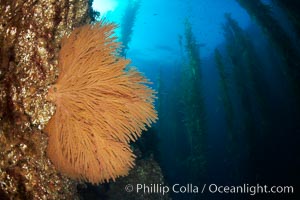
California golden gorgonian on rocky reef, below kelp forest, underwater. The golden gorgonian is a filter-feeding temperate colonial species that lives on the rocky bottom at depths between 50 to 200 feet deep. Each individual polyp is a distinct animal, together they secrete calcium that forms the structure of the colony. Gorgonians are oriented at right angles to prevailing water currents to capture plankton drifting by.
Species: California golden gorgonian, Macrocystis pyrifera, Muricea californica
Location: San Clemente Island, California
Image ID: 23477
Species: California golden gorgonian, Macrocystis pyrifera, Muricea californica
Location: San Clemente Island, California
Image ID: 23477
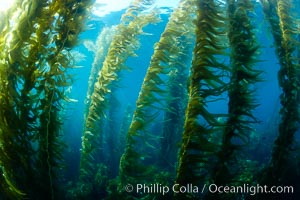
A kelp forest. Giant kelp grows rapidly, up to 2' per day, from the rocky reef on the ocean bottom to which it is anchored, toward the ocean surface where it spreads to form a thick canopy. Myriad species of fishes, mammals and invertebrates form a rich community in the kelp forest. Lush forests of kelp are found through California's Southern Channel Islands.
Species: Giant kelp, Macrocystis pyrifera
Location: San Clemente Island, California
Image ID: 23478
Species: Giant kelp, Macrocystis pyrifera
Location: San Clemente Island, California
Image ID: 23478
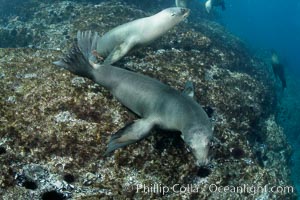
California sea lions, underwater at Santa Barbara Island. Santa Barbara Island, 38 miles off the coast of southern California, is part of the Channel Islands National Marine Sanctuary and Channel Islands National Park. It is home to a large population of sea lions.
Species: California sea lion, Zalophus californianus
Location: Santa Barbara Island, California
Image ID: 23479
Species: California sea lion, Zalophus californianus
Location: Santa Barbara Island, California
Image ID: 23479
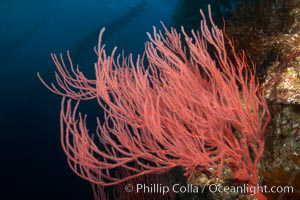
Red gorgonian, underwater. The red gorgonian is a filter-feeding temperate colonial species that lives on the rocky bottom at depths between 50 to 200 feet deep. Gorgonians are oriented at right angles to prevailing water currents to capture plankton drifting by.
Species: Red gorgonian, Leptogorgia chilensis, Lophogorgia chilensis
Location: San Clemente Island, California
Image ID: 23480
Species: Red gorgonian, Leptogorgia chilensis, Lophogorgia chilensis
Location: San Clemente Island, California
Image ID: 23480
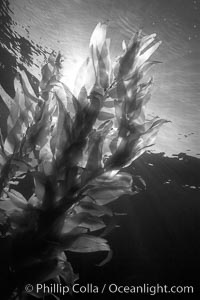
Sunlight filters through a kelp forest, the floating canopy of kelp spreads out on the ocean surface after having grown up from the rocky reef on the ocean bottom, underwater.
Species: Giant kelp, Macrocystis pyrifera
Location: San Clemente Island, California
Image ID: 23481
Species: Giant kelp, Macrocystis pyrifera
Location: San Clemente Island, California
Image ID: 23481
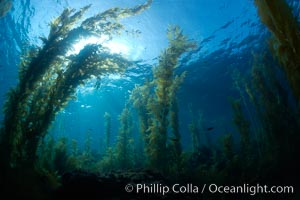
Kelp forest, sunlight filters through towering stands of giant kelp, underwater.
Species: Giant kelp, Macrocystis pyrifera
Location: Catalina Island, California
Image ID: 23482
Species: Giant kelp, Macrocystis pyrifera
Location: Catalina Island, California
Image ID: 23482
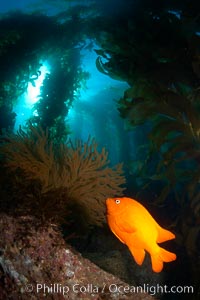
Garibaldi and golden gorgonian, with a underwater forest of giant kelp rising in the background, underwater.
Species: Garibaldi, Hypsypops rubicundus
Location: Catalina Island, California
Image ID: 23483
Species: Garibaldi, Hypsypops rubicundus
Location: Catalina Island, California
Image ID: 23483
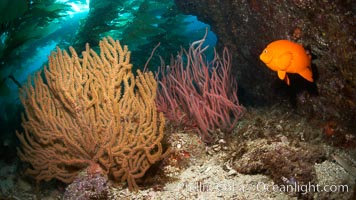
Garibaldi swims beside golden and red gorgonians, underwater.
Species: California golden gorgonian, Red gorgonian, Hypsypops rubicundus, Leptogorgia chilensis, Lophogorgia chilensis, Muricea californica
Location: Catalina Island, California
Image ID: 23484
Species: California golden gorgonian, Red gorgonian, Hypsypops rubicundus, Leptogorgia chilensis, Lophogorgia chilensis, Muricea californica
Location: Catalina Island, California
Image ID: 23484
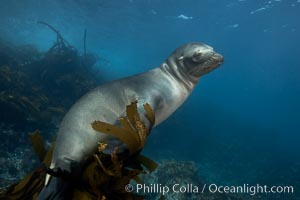
California sea lion, underwater at Santa Barbara Island. Santa Barbara Island, 38 miles off the coast of southern California, is part of the Channel Islands National Marine Sanctuary and Channel Islands National Park. It is home to a large population of sea lions.
Species: California sea lion, Zalophus californianus
Location: Santa Barbara Island, California
Image ID: 23485
Species: California sea lion, Zalophus californianus
Location: Santa Barbara Island, California
Image ID: 23485
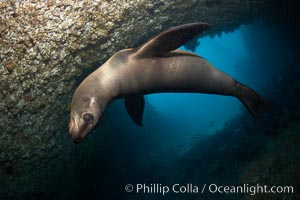
A California sea lion, underwater inside a submarine cavern, at Santa Barbara Island.
Species: California sea lion, Zalophus californianus
Location: Santa Barbara Island, California
Image ID: 23486
Species: California sea lion, Zalophus californianus
Location: Santa Barbara Island, California
Image ID: 23486
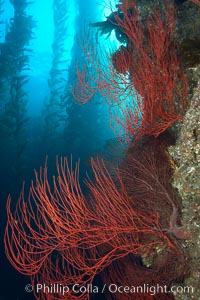
Red gorgonian on rocky reef, below kelp forest, underwater. The red gorgonian is a filter-feeding temperate colonial species that lives on the rocky bottom at depths between 50 to 200 feet deep. Gorgonians are oriented at right angles to prevailing water currents to capture plankton drifting by.
Species: Red gorgonian, Leptogorgia chilensis, Lophogorgia chilensis, Macrocystis pyrifera
Location: San Clemente Island, California
Image ID: 23487
Species: Red gorgonian, Leptogorgia chilensis, Lophogorgia chilensis, Macrocystis pyrifera
Location: San Clemente Island, California
Image ID: 23487
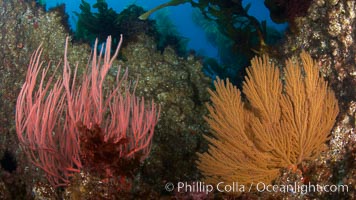
Red gorgonian (left) and California golden gorgonian (right) on rocky reef, below kelp forest, underwater. Gorgonians are filter-feeding temperate colonial species that live on the rocky bottom at depths between 50 to 200 feet deep. Each individual polyp is a distinct animal, together they secrete calcium that forms the structure of the colony. Gorgonians are oriented at right angles to prevailing water currents to capture plankton drifting by.
Species: Red gorgonian, Leptogorgia chilensis, Lophogorgia chilensis
Location: San Clemente Island, California
Image ID: 23509
Species: Red gorgonian, Leptogorgia chilensis, Lophogorgia chilensis
Location: San Clemente Island, California
Image ID: 23509
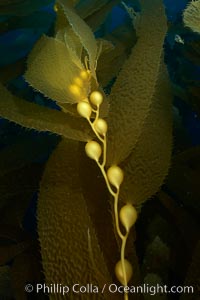
Kelp fronds and pneumatocysts. Pneumatocysts, gas-filled bladders, float the kelp plant off the ocean bottom toward the surface and sunlight, where the leaf-like blades and stipes of the kelp plant grow fastest. Giant kelp can grow up to 2' in a single day given optimal conditions. Epic submarine forests of kelp grow throughout California's Southern Channel Islands.
Species: Giant kelp, Macrocystis pyrifera
Location: San Clemente Island, California
Image ID: 23488
Species: Giant kelp, Macrocystis pyrifera
Location: San Clemente Island, California
Image ID: 23488
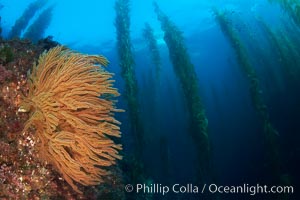
California golden gorgonian on rocky reef, below kelp forest, underwater. The golden gorgonian is a filter-feeding temperate colonial species that lives on the rocky bottom at depths between 50 to 200 feet deep. Each individual polyp is a distinct animal, together they secrete calcium that forms the structure of the colony. Gorgonians are oriented at right angles to prevailing water currents to capture plankton drifting by.
Species: California golden gorgonian, Macrocystis pyrifera, Muricea californica
Location: San Clemente Island, California
Image ID: 23489
Species: California golden gorgonian, Macrocystis pyrifera, Muricea californica
Location: San Clemente Island, California
Image ID: 23489
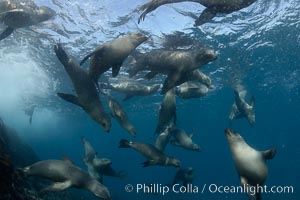
California sea lions, underwater at Santa Barbara Island. Santa Barbara Island, 38 miles off the coast of southern California, is part of the Channel Islands National Marine Sanctuary and Channel Islands National Park. It is home to a large population of sea lions.
Species: California sea lion, Zalophus californianus
Location: Santa Barbara Island, California
Image ID: 23490
Species: California sea lion, Zalophus californianus
Location: Santa Barbara Island, California
Image ID: 23490
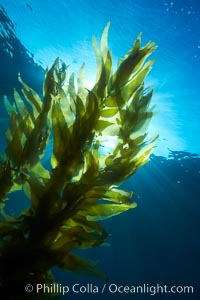
Sunlight filters through a kelp forest, the floating canopy of kelp spreads out on the ocean surface after having grown up from the rocky reef on the ocean bottom, underwater.
Species: Giant kelp, Macrocystis pyrifera
Location: San Clemente Island, California
Image ID: 23491
Species: Giant kelp, Macrocystis pyrifera
Location: San Clemente Island, California
Image ID: 23491
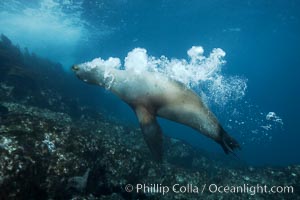
California sea lions, underwater at Santa Barbara Island. Santa Barbara Island, 38 miles off the coast of southern California, is part of the Channel Islands National Marine Sanctuary and Channel Islands National Park. It is home to a large population of sea lions.
Species: California sea lion, Zalophus californianus
Location: Santa Barbara Island, California
Image ID: 23493
Species: California sea lion, Zalophus californianus
Location: Santa Barbara Island, California
Image ID: 23493
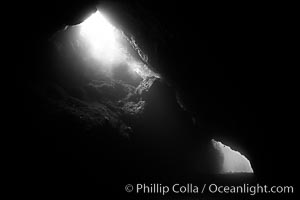
A submarine cavern at Santa Barbara Island, underwater.
Location: Santa Barbara Island, California
Image ID: 23494
Location: Santa Barbara Island, California
Image ID: 23494
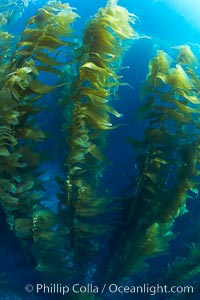
A kelp forest. Giant kelp grows rapidly, up to 2' per day, from the rocky reef on the ocean bottom to which it is anchored, toward the ocean surface where it spreads to form a thick canopy. Myriad species of fishes, mammals and invertebrates form a rich community in the kelp forest. Lush forests of kelp are found through California's Southern Channel Islands.
Species: Giant kelp, Macrocystis pyrifera
Location: San Clemente Island, California
Image ID: 23495
Species: Giant kelp, Macrocystis pyrifera
Location: San Clemente Island, California
Image ID: 23495
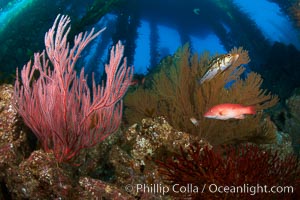
Red gorgonian (left) and California golden gorgonian (right) on rocky reef, below kelp forest, underwater. Gorgonians are filter-feeding temperate colonial species that live on the rocky bottom at depths between 50 to 200 feet deep. Each individual polyp is a distinct animal, together they secrete calcium that forms the structure of the colony. Gorgonians are oriented at right angles to prevailing water currents to capture plankton drifting by.
Species: Red gorgonian, Leptogorgia chilensis, Lophogorgia chilensis
Location: San Clemente Island, California
Image ID: 23496
Species: Red gorgonian, Leptogorgia chilensis, Lophogorgia chilensis
Location: San Clemente Island, California
Image ID: 23496
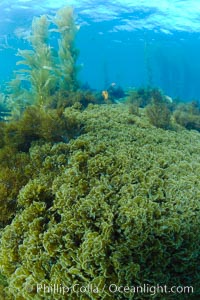
Marine algae, various species, in shallow water underwater.
Location: Catalina Island, California
Image ID: 23497
Location: Catalina Island, California
Image ID: 23497
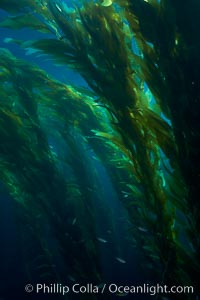
A kelp forest. Giant kelp grows rapidly, up to 2' per day, from the rocky reef on the ocean bottom to which it is anchored, toward the ocean surface where it spreads to form a thick canopy. Myriad species of fishes, mammals and invertebrates form a rich community in the kelp forest. Lush forests of kelp are found through California's Southern Channel Islands.
Species: Giant kelp, Macrocystis pyrifera
Location: San Clemente Island, California
Image ID: 23498
Species: Giant kelp, Macrocystis pyrifera
Location: San Clemente Island, California
Image ID: 23498
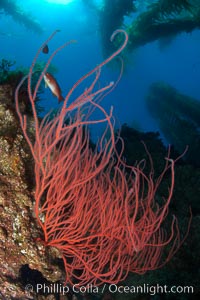
Red gorgonian on rocky reef, below kelp forest, underwater. The red gorgonian is a filter-feeding temperate colonial species that lives on the rocky bottom at depths between 50 to 200 feet deep. Gorgonians are oriented at right angles to prevailing water currents to capture plankton drifting by.
Species: Red gorgonian, Lophogorgia chilensis
Location: San Clemente Island, California
Image ID: 23499
Species: Red gorgonian, Lophogorgia chilensis
Location: San Clemente Island, California
Image ID: 23499
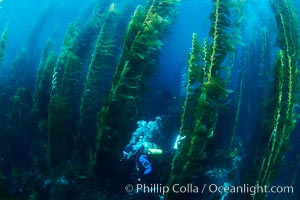
A SCUBA diver, swims through a underwater forest of giant kelp at San Clemente Island.
Species: Giant kelp, Macrocystis pyrifera
Location: San Clemente Island, California
Image ID: 23500
Species: Giant kelp, Macrocystis pyrifera
Location: San Clemente Island, California
Image ID: 23500
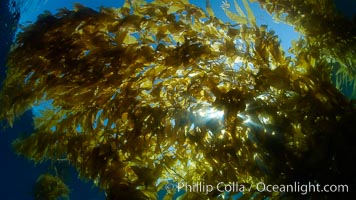
Sunlight filters through a kelp forest, the floating canopy of kelp spreads out on the ocean surface after having grown up from the rocky reef on the ocean bottom, underwater.
Species: Giant kelp, Macrocystis pyrifera
Location: San Clemente Island, California
Image ID: 23501
Species: Giant kelp, Macrocystis pyrifera
Location: San Clemente Island, California
Image ID: 23501
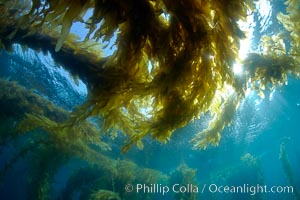
Kelp forest canopy, sunlight filters through giant kelp as it grows up from the sea floor and spread out on the ocean surface, underwater.
Species: Giant kelp, Macrocystis pyrifera
Location: Catalina Island, California
Image ID: 23502
Species: Giant kelp, Macrocystis pyrifera
Location: Catalina Island, California
Image ID: 23502
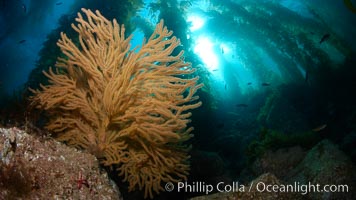
Golden gorgonian and kelp forest, underwater.
Species: California golden gorgonian, Muricea californica
Location: Catalina Island, California
Image ID: 23503
Species: California golden gorgonian, Muricea californica
Location: Catalina Island, California
Image ID: 23503
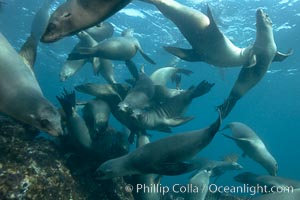
California sea lions, underwater at Santa Barbara Island. Santa Barbara Island, 38 miles off the coast of southern California, is part of the Channel Islands National Marine Sanctuary and Channel Islands National Park. It is home to a large population of sea lions.
Species: California sea lion, Zalophus californianus
Location: Santa Barbara Island, California
Image ID: 23504
Species: California sea lion, Zalophus californianus
Location: Santa Barbara Island, California
Image ID: 23504
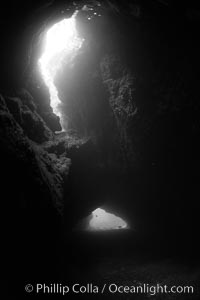
A submarine cavern at Santa Barbara Island, underwater.
Location: Santa Barbara Island, California
Image ID: 23505
Location: Santa Barbara Island, California
Image ID: 23505
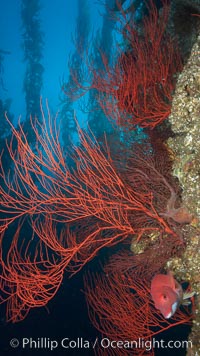
Red gorgonian on rocky reef, below kelp forest, underwater. The red gorgonian is a filter-feeding temperate colonial species that lives on the rocky bottom at depths between 50 to 200 feet deep. Gorgonians are oriented at right angles to prevailing water currents to capture plankton drifting by.
Species: Red gorgonian, Leptogorgia chilensis, Lophogorgia chilensis
Location: San Clemente Island, California
Image ID: 23506
Species: Red gorgonian, Leptogorgia chilensis, Lophogorgia chilensis
Location: San Clemente Island, California
Image ID: 23506